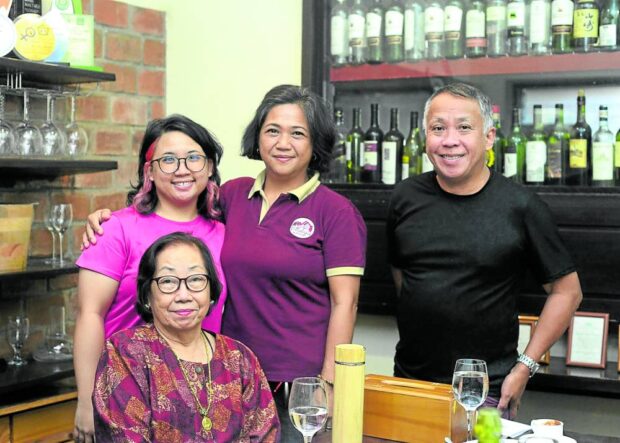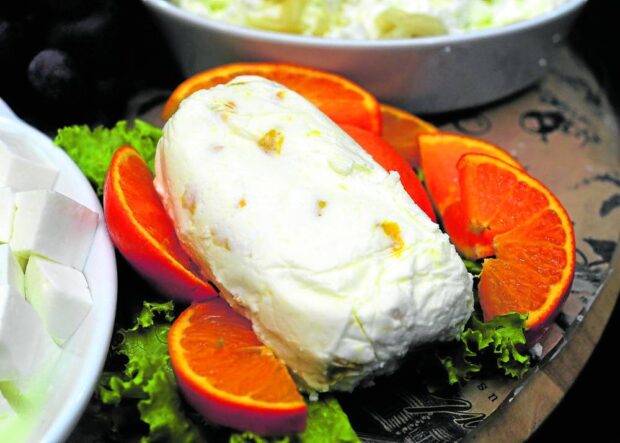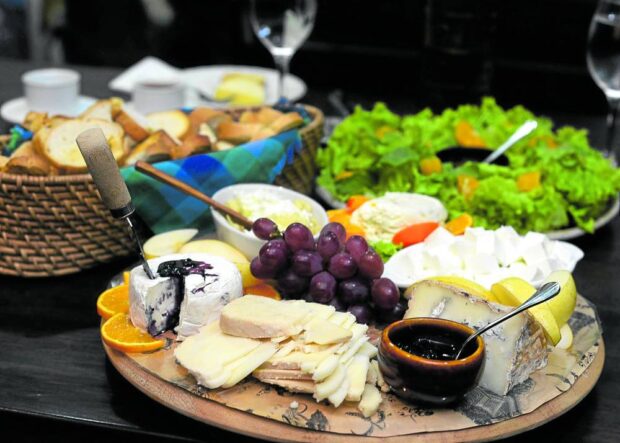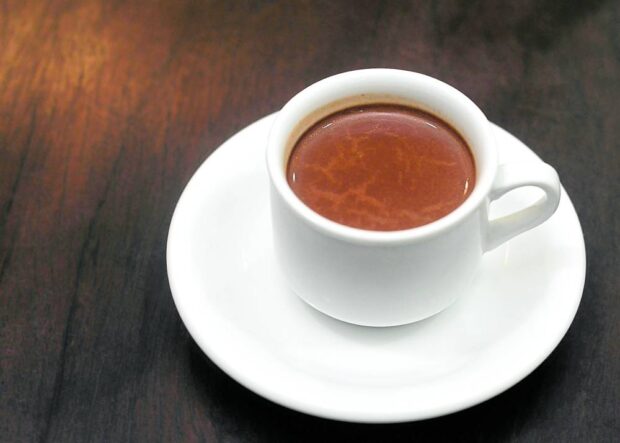Davao making a name for artisanal cheeses, chocolates

People behind the cheeses and chocolates: Ingrid (left), Olive, Rex and Charita Puentespina in front. —photos by BING GONZALES
DAVAO CITY—While some cheese houses in Europe endure for more than a hundred years specializing on only one type of cheese, it sometimes strikes people to know that Malagos Farmhouse here has been making up to 30 varieties of cheese, at least, before the pandemic.
Cheesemaker Olive Puentespina said she had often been asked why she made such a large selection of cheeses and, often, her reply was, “Because nobody told me I can’t do it.”
She compared herself to a child who just started to learn and explore that it would be too self-limiting for her to stop. “If I started learning in traditional schools, I would have been boxed in. They’d say, ‘No, no, no, you can’t do that’—and I wouldn’t have been able to do it.”
In 2005, when she first started making cheese, she amazed European chefs and cheesemakers who were surprised at what cheeses she was making in 30-degree Celsius weather. Malagos Farmhouse makes cheeses that were initially thought cannot be done here—from fresh goat cheese, feta to camembert and blue cheese.
Now, with her daughter Ingrid taking over the cheese room while she’s focusing on the family’s fertilizer business left by her late husband, Roberto Jr., Puentespina thinks it is high time to focus on a few bestsellers and artisanal lines that they can produce more of.
“Let’s narrow down the line,” she said. “If you want to grow big, concentrate.”
So, Malagos Farmhouse trimmed down its line from 30 cheese varieties before the pandemic to only 27; and further down to 13.
When the Inquirer team visited her outlet on Bolcan Street here recently, she prepared a platter full of cheeses: Malagos’ version of kesong puti (white cheese) from fresh goat’s milk; its Mango Sublime —actually made in the style of French chevre infused with mango; Sophia, a soft feta aged in garlic-infused olive oil; camembert; borracho (“lasenggo”) or goat cheese aged in Cerveza Negra; and blue goat cheese, which is aged using blue mold.

BESTSELLER Mango Sublime is cheese made in the style of chevre (French goat’s cheese) but with mango in it. Filipinos love this cheese best, says cheesemaker Olive Puentespina.
Manila, then the world
Davao City may have elevated durian to a level of an icon but two Malagos products—local chocolates and cheese—have placed the city in the global map of artisanal chocolate and cheese makers. The two products did not come at the same time. For it was the cheeses, though still hardly known in Davao, that had first gained a reputation among hotels in Metro Manila.
When people who had tasted it in Manila would come here, looking for the cheeses, locals would not know, so they’d bring the visitors to the family’s mountain resort in Malagos. “The [visitors] get furious because there are no cheeses there,” Olive recalled.
She used to keep her cheeses inside a small refrigerator installed near the flower display inside the Puentespina compound on Bolcan Street, where people used to go to buy orchids and other ornamentals that her mother-in-law, the family matriarch Charita Puentespina, was famous for.
“So people, who used to come for the flowers, would make a side trip for the cheese,” Olive said. “As the years went by, people already came here for the cheese,” she said, adding that she became a bit anxious when one day her visitors even included some senators.
Malagos chocolates came when the cheeses had already established its reputation among Manila chefs. “[During those times], we had a hard time convincing the chefs that the tablea can also be used as an ingredient in cake making because they preferred the imported couvertures,” recalled mother-in-law Charita. “So when [Olive] did her thing with the chefs, we also had to make a lot of effort to push for the local artisanal chocolate because it was not known,” Charita said. “Malagos chocolate was still making its name then.”
Her son (and Olive’s brother-in-law) Rex Puentespina, who runs the Malagos Agriventures Inc. that oversees the family’s cacao growing and chocolate business, recalled bringing the Malagos chocolates to the Anuga food and beverage fair in Cologne, Germany, in 2015.
“As people passed by the Philippine booth, they raised their brows when they saw the Malagos chocolates on display. They only expected bananas and tunas from the Philippines. But when they tasted it, they were surprised that it tasted just as good [as well known foreign chocolates]—even better,” Rex said.
He said that the Philippines, which grows its own cacao, had a very big potential to compete in chocolates because Europe procures its cacao beans from countries near the equator. “Come to think of it, chocolate makers in Switzerland, The Netherlands, Europe, source their raw materials from the equator so the Philippines is in the good position to sell in terms of flavor,” he said.
In the United States, craft makers are after a flavor derived from the source of the bean, the quality of which the taste of the chocolate depends on. In Malagos, we have an even rainfall, the soil and our elevation that created its unique terroir,” he said.
Malagos Chocolates made use of good genetic material and was among the first to adopt bean fermentation. “Just like cheese, we start with good raw materials and we don’t compromise,” Rex said.

A platter of Malagos cheeses produced by Malagos Farmhouse.
Int’l recognition
Malagos won its first award in international chocolate competition in 2015 and, in the last three or four years, it had won eight international awards. The stir that Malagos chocolates created in the international scene perked the attention of chocolate makers, who started looking at the Philippines as a good source of best tasting cocoa beans.
Malagos had exported cacao beans to niche markets in Canada, Taiwan, Singapore and Thailand until it was able to set up its chocolate factory at the Malagos Farm and started making its own chocolate bars.
But while the chocolates immediately became popular, the Malagos cheese remained entrenched in its niche and continued to grow. Olive continued to experiment to make the European cheeses “Filipino.”
“I infused the cheeses with Philippine berries and fruits like mango and pineapple so that it can be recognized as a Filipino product,” she said. Hence, the Malagos cheese “sublime line,” actually cheeses in the style of French chevre but featuring mango or pineapple in it.

A steaming cup of Malagos chocolate drink
Mother, daughter team
In 2009, Olive was both delighted and surprised when she learned that her daughter Ingrid had taken interest in cheesemaking.
“She was still 11 years old and she had seen me working too hard when one day, she approached me and said, ‘Mommy, can I apply as your apprentice?’” Olive recalled. “She did not say, ‘Do this, Mommy, you have to teach me,’ No. She said, ‘Can I be an apprentice?’ So, I was taken aback and asked, ‘Anak, what do you want to bring naman? How are you going to do it?’ and she said, ‘I’d study food science, Ma, and between your art and my science, we would be unbeatable,’” was her daughter’s reply.
When she first let her join in making cheese, she was teary-eyed when she watched her handle the curd for the first time. “At that age, she was still very small but her movement was so smooth and so natural, it was as if she was doing it all her life, she looked so comfortable,” Olive recalled. She said her daughter was always excited and very eager to learn. “So I had to teach her how to be patient because cheese is not a fast food, it’s a slow food,” Olive said.
When Ingrid was in high school, she was allowed to make small cheeses during school breaks. Then, one day, she gave her 100 liters of milk, which Ingrid developed into a cheese she called Ingrid’s Rosemary in the style of gouda.
Ingrid was admitted to the food engineering program at the University of the Philippines in Diliman where she graduated cum laude. She later placed third during the board exams. Soon after graduation, she had to take over her mother’s cheese room as her mother had to run the family’s fertilizer business after the passing of her father, Dr. Robert Puentespina Jr., a veterinarian popularly known as “Dr. Bo” of the Malagos Bird Show, in 2001.
Olive said Malagos Farmhouse wants to broaden the Filipino’s appreciation for cheese.
Unlike chocolates, whose raw materials come from cacao that can be cheap because they are being grown in Mindanao, goats are not producing that much milk in hot weather, hence, milk remains expensive. In Europe, dairy is cheap because it’s being produced there, she said.
Of the 30 cheese varieties she made, Olive knows which one Filipinos love best: it is her Mango Sublime.
She wants to make it cheaper to make it affordable to Filipino buyers. But she can only lower the price if she can make goat’s milk cheaper.
“So I told Ingrid, if you really want to bring the company on a different [level], just make sure that we will retain the artisan line, and we can create another line that will be more affordable but will not compromise on the quality, the taste and, of course, the brand,” Olive said.